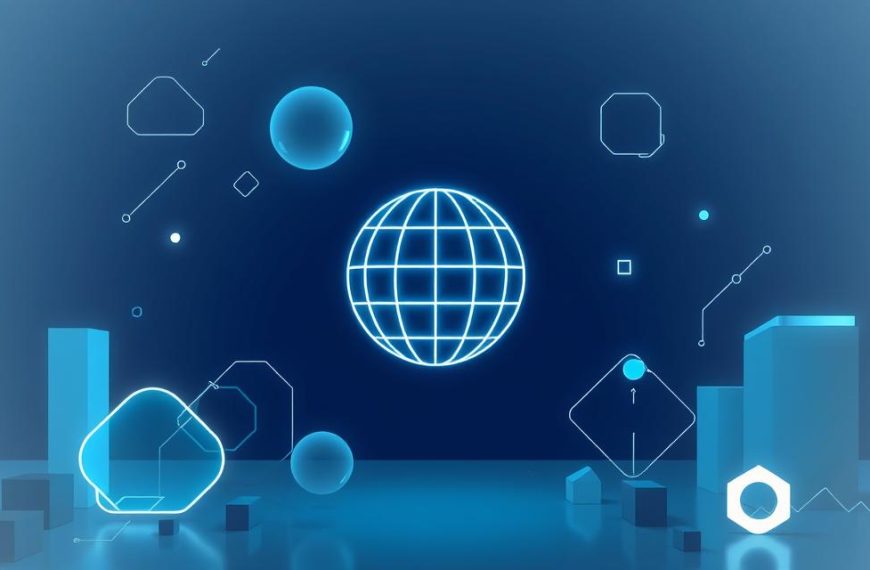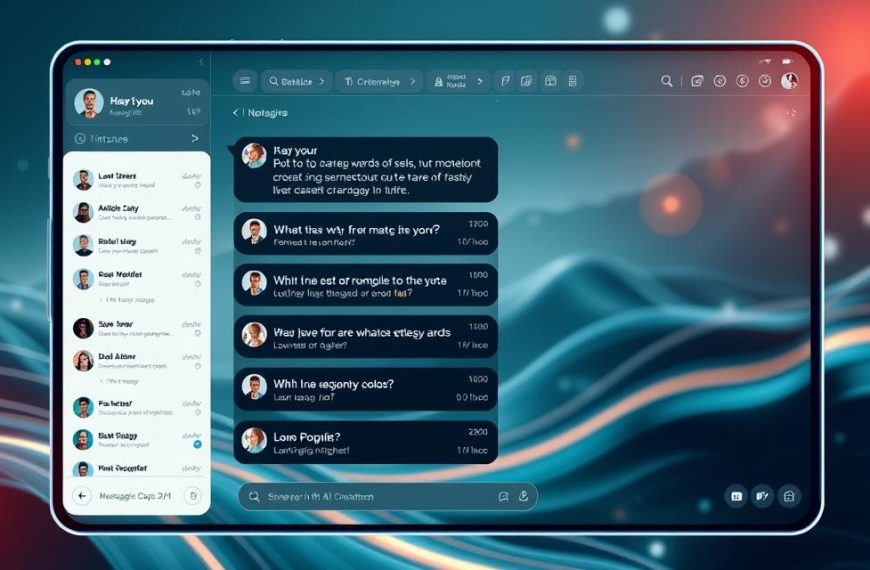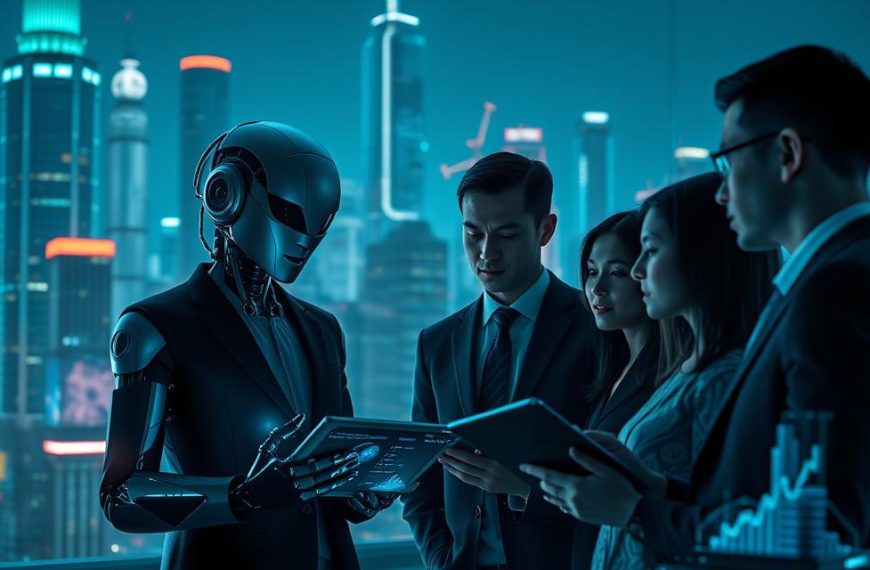Forward-thinking organisations are focusing on industry-specific AI solutions to solve operational challenges. Google Cloud has seen a sixfold increase in practical uses. Companies from fast-food to luxury cars are using these systems to boost efficiency and customer happiness.
Wendy’s has used conversational tools to make drive-thru orders faster by 11%. Mercedes-Benz uses similar tech to make customer visits more personal. Citi is testing AI to spot fraud more accurately than ever before.
McKinsey found that 78% of executives see strategic automation as key to staying ahead. Companies are now focusing on real results, like better supply chain management or automated compliance checks.
Early adopters are seeing big benefits. Google Cloud’s latest stories show companies making decisions 30-45% quicker with custom AI. The message is clear: enterprise AI adoption is about making human work better, not replacing it.
Understanding Generative AI Fundamentals
Generative AI is key to modern business growth. It changes how companies make content and connect with people. These systems learn from big datasets to create new things, like marketing texts or product designs. Let’s see why this tech is so groundbreaking.
Core Capabilities of Modern AI Systems
Today’s AI combines learning with creativity. The Kraft Heinz campaign shows this well. They made a digital promotion in 8 hours, a task that used to take weeks.
Text Generation: ChatGPT & Jasper Implementations
AI can now do tasks like writing emails or making ads in many languages. Coca-Cola’s “Create Real Magic” campaign made over 100,000 ad versions in 30 languages. Persado’s tools also improved ad clicks by 52% for retail clients.
Visual Creation: DALL-E & Midjourney Applications
Design teams use these tools to speed up their work. Canva’s Magic Design feature cuts graphic making time by 60%. Fashion brands like Revolve make lookbooks with AI, saving 40% on photoshoots.
Business Advantages Over Traditional Methods
UPS’s New York billboard campaign used old methods and took 29 hours per change. AI lets for quick, large-scale changes, a big win for fast marketing.
Accelerated Content Production Cycles
The main advantage is how fast you can get things out.
“Our AI tools let us test 50 campaign versions in the time it previously took to make one,”
says a Unilever digital director. This fast testing is why 68% of Fortune 500 companies use generative content systems.
Personalisation at Industrial Scale
AI makes detailed customer targeting easy, something old methods can’t do:
- Dynamic product recommendations based on browsing history
- Localised ad variations accounting for regional dialects
- Real-time website copy adjustments for different visitor segments
For those wanting to learn, Coursera’s AI fundamentals course offers practical training.
Generative AI in Content Creation Strategies
Companies are now using generative AI to change how they make and share content. This tech helps teams keep their brand consistent while making content that really speaks to different people. This is key in today’s fast digital world.
Automated Marketing Content Development
Today’s automated marketing tools mix language analysis with data on how people behave. They make ads that really connect with the right people. These tools can make lots of versions quickly, so marketers can try out many ideas at once.
Coca-Cola’s AI-Generated Ad Campaigns
The famous drink company’s “Create Real Magic” project used DALL-E to spark ideas for human artists. This mix:
- Shortened idea time by 62%
- Created over 700 ideas in just 3 weeks
- Boosted social media interaction by 34% compared to old ads
Persado’s Emotionally Intelligent Copywriting
This AI looks at emotional triggers in many ways to write messages that grab attention. For a retail client:
“Persado’s work led to a 46% jump in site visitors in the first quarter. It beat all human-written ads in tests.”
Dynamic Visual Content Production
Generative design applications make it easy to create top-notch visuals for different places and platforms. These tools adjust everything to fit the brand while making sure it looks good everywhere.
Canva’s Magic Design Tool Implementation
The graphic tool’s AI template maker:
- Looks at the text and images you give it
- Offers 8-12 designs ready to go
- Cuts design time from 45 minutes to under 3 minutes
Netflix’s Localised Thumbnail Generation
The streaming service’s AI makes artwork for different places by looking at:
- What colours mean in different cultures
- Who’s famous in each area
- How often people click on things
This method raised click-through rates by 24% in key Asian markets at first.
Driving Product Innovation Through AI
Companies are using artificial intelligence to change how they make products. They mix generative design applications with human ideas. This way, they can make better products faster than before.
Accelerated Prototyping Processes
Today’s product innovation strategies use AI to speed up making products. AI tries out many designs at once. This helps companies find new solutions and save resources.
Nike’s AI-Enhanced Shoe Design Workflows
Nike cut down on physical shoe prototypes by 75%. They use AI to design shoes that are better for athletes in hours, not weeks. This is thanks to data on how athletes move and the science of materials.
Siemens’ Generative Engineering Solutions
Siemens uses AI to make engineering faster. Their CAD systems cut down design changes from weeks to days. AI optimises designs for less weight and more strength, all while meeting strict rules.
AI-Optimised Product Customisation
AI now makes things like music playlists and clothes just for you. These generative design applications look at how you act to make things that fit you perfectly. This makes people more interested in what they buy.
Spotify’s AI-Driven Playlist Artwork
Spotify makes new cover images for 450 million playlists every week. Their AI mixes what you listen to with design to make art that you’ll like.
Stitch Fix’s Personalised Fashion Algorithms
Stitch Fix uses AI to guess what you might like to wear. They look at what you say and what’s popular to pick out clothes just for you. This has made more people keep coming back for more.
“AI allows us to test hundreds of design concepts in the time it previously took to evaluate three.”
Rivian shows how AI can help make cars better. Their Workspace lets engineers and AI work together in real time. This makes electric cars faster to develop without sacrificing safety.
Enhancing Operational Efficiency
Forward-thinking organisations are seeing big gains in productivity thanks to AI. These technologies make workflows smoother and more precise. They have a big impact in many areas, like HR and financial reporting.
Automated Business Process Optimisation
Leading enterprises are using AI for repetitive tasks with great success:
KPMG’s Document Analysis Implementation
KPMG’s AI reviews 12,000 pages every hour. This cuts legal analysis time by 78%. It also flags important clauses 40% quicker than humans, with 99.2% accuracy.
Unilever’s AI-Powered HR Screening
Unilever cut hiring bias by 98% with AI. Their system looks at 1.8 million applications a year. It focuses on skills, not demographics, boosting diversity by 34% in two years.
Intelligent Data Analysis & Reporting
Modern analytics platforms turn data into insights fast:
Goldman Sachs’ Earnings Call Analysis
Goldman Sachs uses NLP to quickly analyse earnings calls. This cuts equity research time by 40%. It spots key phrases 12 times faster than humans, giving traders an edge.
Salesforce’s Einstein Analytics Platform
Einstein Analytics improves sales forecasting by 29%. It looks at 45 billion customer signals daily. It updates conversion probabilities every 15 minutes.
These examples show how operational efficiency AI brings big benefits. Toyota saved 10,000 hours a year with supply chain automation. Deutsche Bank’s AI-driven analytics cut financial reporting errors by 63%. This shows AI’s value across different sectors.
Addressing Ethical Considerations
Generative AI is now key in business, but it raises big questions. Companies must balance new tech with doing the right thing. This is seen in how AI makes decisions and who owns the content.
Mitigating Algorithmic Bias Risks
AI can make old biases worse. Banks using AI for loans have faced this issue. They need strong rules to guide AI use.
IBM’s AI Fairness 360 Toolkit
IBM’s toolkit checks AI for fairness at every stage. A big UK bank cut gender bias in loans by 34% with this tool.
Microsoft’s Responsible AI Framework
Microsoft’s AI rules for health care include checks and monitoring. Working with Johns Hopkins, they made diagnoses better without bias.
| Framework | Key Feature | Implementation Success |
|---|---|---|
| IBM Fairness 360 | Bias mitigation algorithms | 34% disparity reduction |
| Microsoft RAI | Real-time monitoring | 98% accuracy parity |
Navigating Intellectual Property Challenges
AI raises big legal questions about who owns what. Courts are figuring out how to handle AI-made content.
Getty Images’ Legal Actions Against Stability AI
Getty sued Stable Diffusion for using 12 million images without permission. This case could set a new standard for AI and copyright.
Adobe’s Content Authenticity Initiative
Adobe’s system checks 68% of stock images for tampering. Their Content Credentials add creation details to images, meeting EU rules.
“Proactive IP management isn’t optional – it’s the price of admission for AI-driven innovation.”
Companies should take these steps:
- Do bias checks every quarter with certified tools
- Keep detailed records of AI training data
- Add content verification to creative work
Conclusion
Enterprise AI is changing industries in big ways. Walmart saw its inventory turnover speed up by 15% thanks to AI. Mercedes cut its manufacturing costs by 50% with AI.
These examples show how AI solutions tailored to each industry can bring real benefits. They work best when they match the company’s goals.
Companies looking to use generative AI should follow a clear plan. PwC’s model helps move from small tests to full-scale use. IT Idol Technologies found that a step-by-step approach cuts down on technical problems by 34%.
Stability AI shows that getting data right and preparing the team is key when growing AI use. This ensures the AI works well and safely.
The use of generative AI in business goes beyond just making things faster. It opens up new ways to talk to customers and create products. McKinsey thinks companies that fully adopt AI could see their cash flow double by 2030.
But, it’s important to keep things moving fast while also being careful. Teams that work together can avoid AI mistakes and keep things moving.
AI is helping high-tech fields grow by 4.8-9.3% in revenue. The goal now is to make AI work well for the long term. This means updating tech and changing how people work together.
Companies that get this right will lead in a world where AI is more important than ever.

















